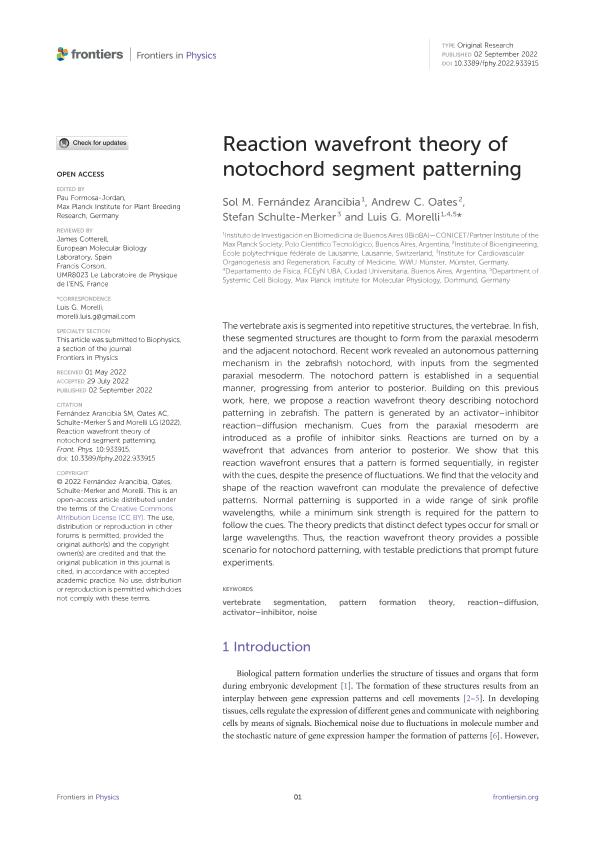Mostrar el registro sencillo del ítem
dc.contributor.author
Fernández Arancibia, Sol Maria

dc.contributor.author
Oates, Andrew C.

dc.contributor.author
Schulte Merker, Stefan
dc.contributor.author
Morelli, Luis Guillermo

dc.date.available
2023-09-28T18:12:23Z
dc.date.issued
2022-09
dc.identifier.citation
Fernández Arancibia, Sol Maria; Oates, Andrew C.; Schulte Merker, Stefan; Morelli, Luis Guillermo; Reaction wavefront theory of notochord segment patterning; Frontiers Media; Frontiers in Physics; 10; 9-2022; 1-14
dc.identifier.uri
http://hdl.handle.net/11336/213491
dc.description.abstract
The vertebrate axis is segmented into repetitive structures, the vertebrae. In fish, these segmented structures are thought to form from the paraxial mesoderm and the adjacent notochord. Recent work revealed an autonomous patterning mechanism in the zebrafish notochord, with inputs from the segmented paraxial mesoderm. The notochord pattern is established in a sequential manner, progressing from anterior to posterior. Building on this previous work, here, we propose a reaction wavefront theory describing notochord patterning in zebrafish. The pattern is generated by an activator–inhibitor reaction–diffusion mechanism. Cues from the paraxial mesoderm are introduced as a profile of inhibitor sinks. Reactions are turned on by a wavefront that advances from anterior to posterior. We show that this reaction wavefront ensures that a pattern is formed sequentially, in register with the cues, despite the presence of fluctuations. We find that the velocity and shape of the reaction wavefront can modulate the prevalence of defective patterns. Normal patterning is supported in a wide range of sink profile wavelengths, while a minimum sink strength is required for the pattern to follow the cues. The theory predicts that distinct defect types occur for small or large wavelengths. Thus, the reaction wavefront theory provides a possible scenario for notochord patterning, with testable predictions that prompt future experiments.
dc.format
application/pdf
dc.language.iso
eng
dc.publisher
Frontiers Media

dc.rights
info:eu-repo/semantics/openAccess
dc.rights.uri
https://creativecommons.org/licenses/by/2.5/ar/
dc.subject
ACTIVATOR–INHIBITOR
dc.subject
NOISE
dc.subject
PATTERN FORMATION THEORY
dc.subject
REACTION–DIFFUSION
dc.subject
VERTEBRATE SEGMENTATION
dc.subject.classification
Otras Ciencias Físicas

dc.subject.classification
Ciencias Físicas

dc.subject.classification
CIENCIAS NATURALES Y EXACTAS

dc.subject.classification
Biología del Desarrollo

dc.subject.classification
Ciencias Biológicas

dc.subject.classification
CIENCIAS NATURALES Y EXACTAS

dc.title
Reaction wavefront theory of notochord segment patterning
dc.type
info:eu-repo/semantics/article
dc.type
info:ar-repo/semantics/artículo
dc.type
info:eu-repo/semantics/publishedVersion
dc.date.updated
2023-07-10T11:51:18Z
dc.identifier.eissn
2296-424X
dc.journal.volume
10
dc.journal.pagination
1-14
dc.journal.pais
Suiza

dc.journal.ciudad
Lausana
dc.description.fil
Fil: Fernández Arancibia, Sol Maria. Consejo Nacional de Investigaciones Científicas y Técnicas. Oficina de Coordinación Administrativa Parque Centenario. Instituto de Investigación en Biomedicina de Buenos Aires - Instituto Partner de la Sociedad Max Planck; Argentina
dc.description.fil
Fil: Oates, Andrew C.. Ecole Polytechnique Fédérale de Lausanne; Suiza
dc.description.fil
Fil: Schulte Merker, Stefan. Westfälische Wilhelms Universität; Alemania
dc.description.fil
Fil: Morelli, Luis Guillermo. Consejo Nacional de Investigaciones Científicas y Técnicas. Oficina de Coordinación Administrativa Parque Centenario. Instituto de Investigación en Biomedicina de Buenos Aires - Instituto Partner de la Sociedad Max Planck; Argentina. Universidad de Buenos Aires. Facultad de Ciencias Exactas y Naturales. Departamento de Física; Argentina. Institut Max Planck fur Molekulare Physiologie; Alemania
dc.journal.title
Frontiers in Physics
dc.relation.alternativeid
info:eu-repo/semantics/altIdentifier/url/https://www.frontiersin.org/articles/10.3389/fphy.2022.933915/full
dc.relation.alternativeid
info:eu-repo/semantics/altIdentifier/doi/http://dx.doi.org/10.3389/fphy.2022.933915
Archivos asociados
